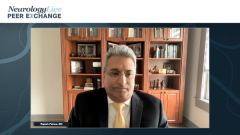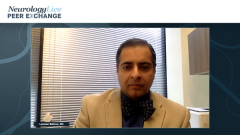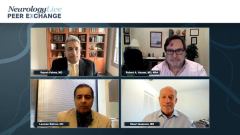
Assessing Effectiveness of OFF Episode Treatment in PD
Laxman Bahroo, DO, examines the effectiveness of on-demand therapies to manage OFF episodes in Parkinson disease and highlights the importance of frequent monitoring and follow-up visits.
Episodes in this series

Stuart Isaacson, MD: Laxman, how do you assess whether that treatment worked to work quicker? By avoiding the GI tract, do you get a more rapid ON? What do you do when you’re still having a problem? Do you go straight to surgical options, or are there other options that you can think about doing in patients who are hesitant to go through surgical options at that point?
Laxman Bahroo, DO: It’s important to assess it. In terms of studies, these therapies are helpful in proving a sooner ON, a faster ON, and maybe even a more reliable ON in many ways. One of the biggest challenges is these are therapies that a patient must administer. If a person doesn’t administer it, it’s not going to work. Many times we have patients who we’ve given on-demand therapies to, and they still call and complain about OFFs. You say, “Why didn’t you treat this?” They say, “I didn’t realize that this is what was used for.” We talked about that, but we may have talked about it in the context of when they’re treating it in the morning…. It never occurred to the patient that they could use it for different times. I always tell them that if you have an OFF episode, this is what the medication is used for. It’s designed to bridge you or rescue you, depending on where they are in their OFF, to turn them on.
Many times, I want to get feedback that the therapies are working. We’re relying on the patient, but we want their caregiver. Sometimes I want a video of this. I’ll tell them when you give yourself an inhaled levodopa or sublingual or subcutaneous apomorphine, send me a video of what you look like as you’re taking it. How OFF are you? Sometimes it’s easier to see if I can see a get-up-and-go test or if I can see what they look like, maybe a 30-second video. Then 10 to 15 minutes later, send me a video of what that looks like. Bring it to the next visit. I want to see how effective it is.
Let’s say it’s not effective. Let’s say the first therapy we picked—whichever 1, let’s say the inhaled levodopa or the sublingual apomorphine—isn’t effective. The first thing I look at is, did you administer it correctly? The administration is the key. Did you administer it early into your OFF period, or did you wait till you absolutely hit OFF and then start it? Maybe it doesn’t work as well when you take it much later, especially for the inhaled and the sublingual. Did we administer it correctly? Did we administer the right dose? Did you administer 2 capsules for the inhaled levodopa? Some people say I’m only going to do 1— they’re afraid of going to 2, and they felt 1 would be enough.
Did you administer it correctly at the right time? Did you administer the correct dosage? If they’re on the sublingual apomorphine, I tell them that you may be at a starting dose. Starting dose is 10 mg. Maybe we need to advance you. We do that in several ways. The nursing service can do it, we can do it in the office, or we can do it virtually if they have the ability to measure their blood pressure and there’s a caregiver at home or a nurse practitioner who can do it. The same thing applies to subcutaneous apomorphine. If you’re not on the right dosage, then you’re not feeling the full response. To advance that, we have the nurse come to your house and evaluate. Is it a dose technique, do you understand how to inject correctly, are you at the right dosage, or do you just need education on where the OFFs are occurring and how to promptly dose?
Those discussions invariably will involve the provider, the patient, and the caregiver: how to dose correctly, dosing at the appropriate times, using the right dosage. Once we’ve reached the point where they’re not getting an effective response, then maybe we’re going to change the baseline. In other words, we’ve added the on demand, but we’re not getting a good enough response. Are we undermedicated at other times? If we are, that’s fine; we can adjust that. If not, then we can talk about surgical therapies, perhaps a GI [gastrointestinal] infusion like a carbidopa-levodopa solution. Or do we talk about DBS [deep brain stimulation]? Those are the options we have. With those options, there’s a gap between our on-demand and adjunct therapies and our surgical therapies.
Transcript Edited for Clarity
Newsletter
Keep your finger on the pulse of neurology—subscribe to NeurologyLive for expert interviews, new data, and breakthrough treatment updates.







